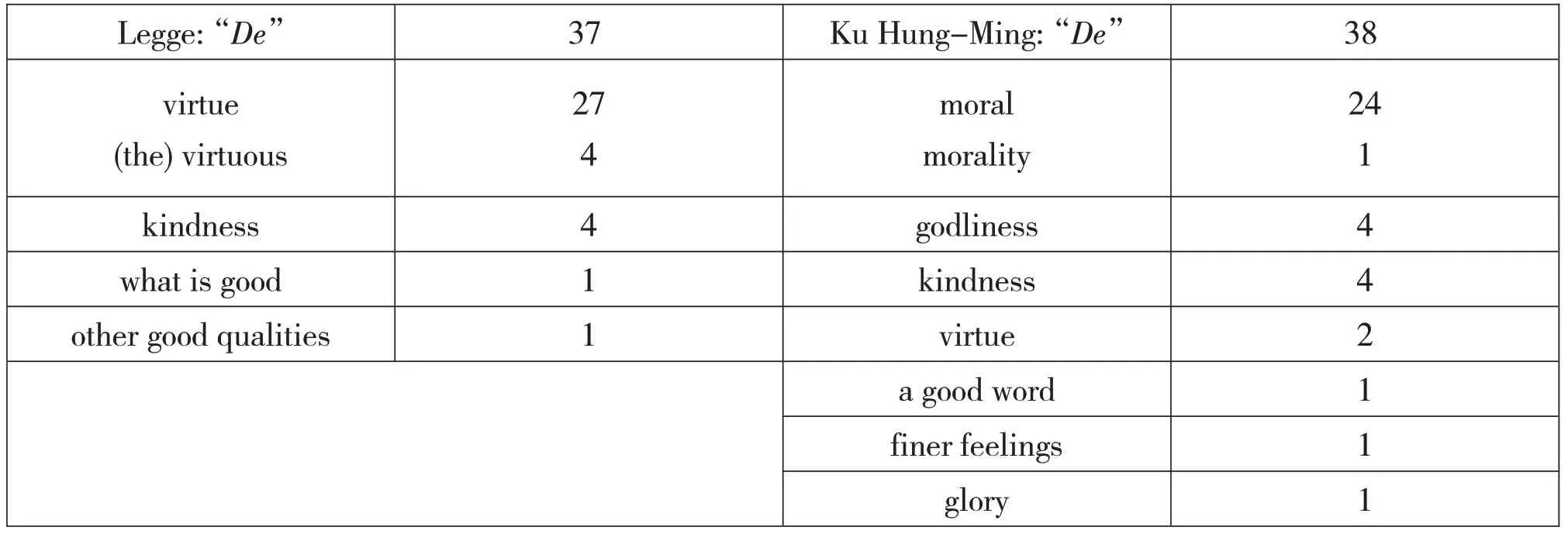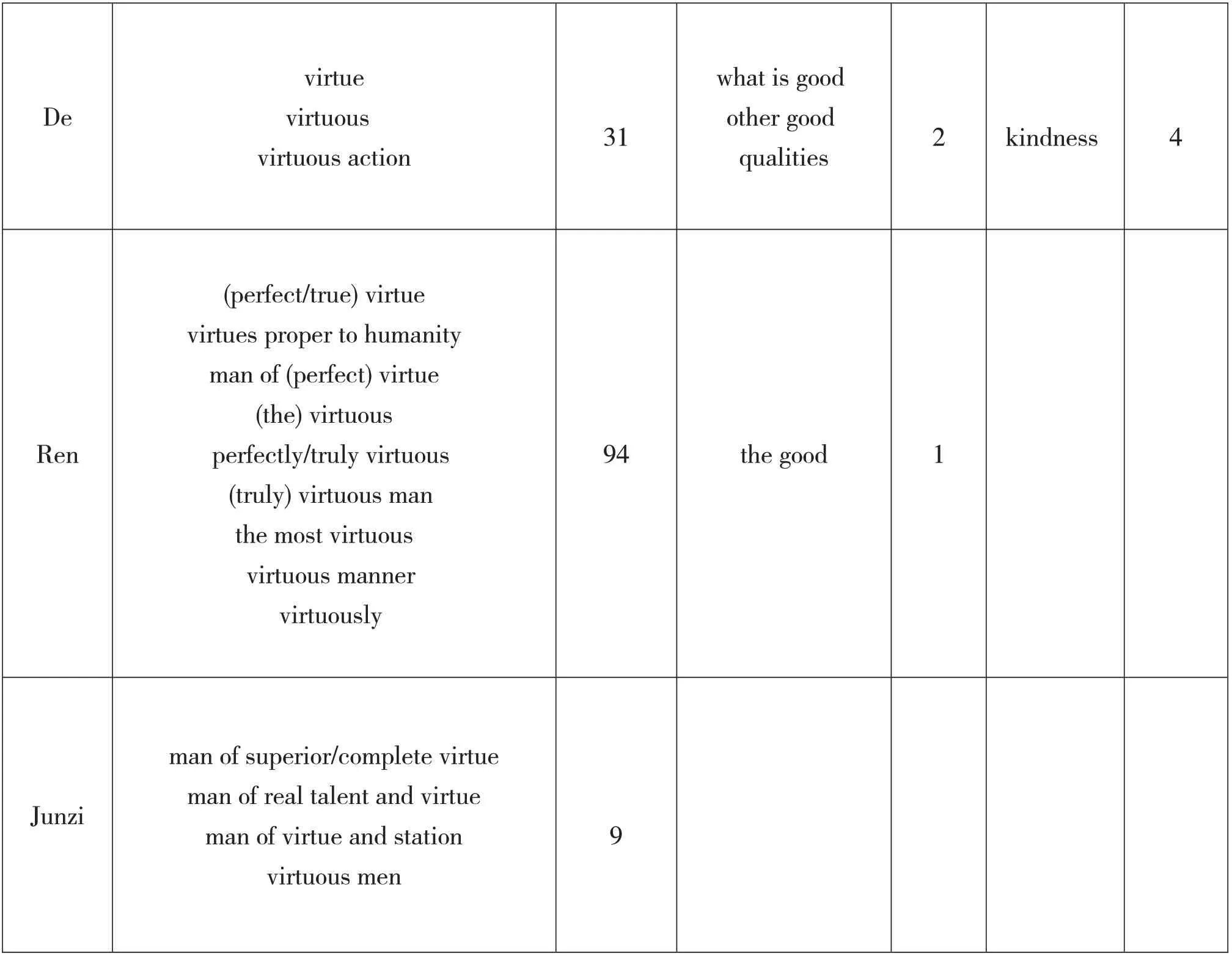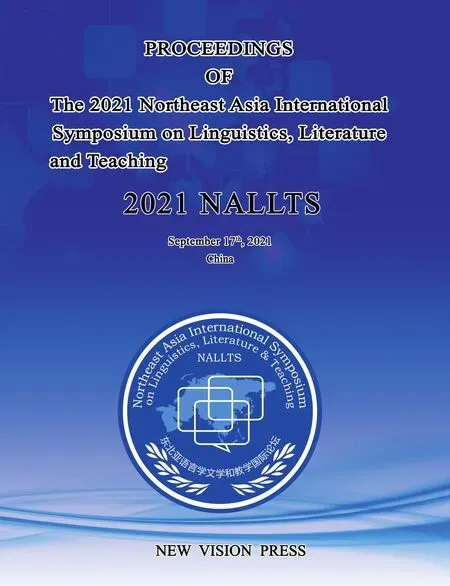Make a Better Story of China:Cross-lingual Presentation of the Subtopic"De"(德)of Lun Yü
Chen Qingxin
Shaanxi Normal University,Xi'an,China
Ordos Institute of Technology,Ordos,China
Email:cqx131421@126.com
[Abstract] Fragmentation of Lun Yü often leads readers to ignore its unity of thoughts.As a matter of fact,Lun Yü is highly logic,with many chapters centering around certain topics.These topics are named subtopics,which support discourse topic and make it clear.The interaction of discourse topic and subtopics can make the text coherent.In cross-lingual presentation,the coherence of topics can reduce the misunderstanding of targeted readers,make the whole text coherent and cohesive,help to regulate and promote the proper understanding and broad acceptance of the translated Chinese classics,and help to make a better story of China and make the voice of China better heard.Therefore,the paper discusses the coherence of one subtopic of Lun Yü:"De",and finds that the coherence of the subtopic is greatly affected by the following factors:one Chinese word is translated into several different English words;different Chinese words are rendered into the same English word.Therefore,the coherence of the text is to some degree affected.
[Keywords] subtopic;Lun Yü;De
Introduction
As a representative of the ancient Chinese philosophical classics,the translation ofLun Yübegan as early as the end of the 16th century,and versions of various languages have been in public since then.Among these,the amount of English versions is the largest:until now more than one hundred English versions have been published according to my counting.Among these,many versions have aroused the interest of scholars both at home and abroad,and the ones translated by James Legge,a missionary and sinologist,and the Chinese scholar Ku Hung-ming have always been the focus of the public.The paper will take their versions as examples to discuss if their translations of the subtopic"De"contributes to the coherence of the whole text(the discourse topic"Ren"and its subtopics"Li"and"Junzi"have been discussed in another paper).
A coherent text often has an explicit or implicit discourse topic and several subtopics."Ren"has been regarded as the discourse topic without much dispute.Other subtopics are seen as indispensable parts of the coherence of the text.Wu Xiaoming(Wu,2003,p.22)points out that to some extent such words asZhong(忠),Shu(恕),Xiao(孝),Ti(悌),Jing(敬),Li(礼),Zhi(智)andXin(信)are the manifestations of Confucius'"Ren".In other words,these words are the subtopics ofLun Yü.They support the discourse topic"Ren"with different forms.The interaction of discourse topic and its subtopics can make the whole text coherent and cohesive.The paper chooses the subtopic "De"as the focus.
"De"appears inLun Yüfor 40 times.Chan Wing-tsit(Chan,1963,p.790)points out that"De"means"virtue"or"character".It"ordinarily means moral character but in relation to Tao it means Tao particularized when inherent in a thing.The classical definition of it is tote(attain or be able to)."In essence,"De"has different connotations in different contexts.It can refer to the moral character,it can refer to the good qualities of persons,but in several cases,it describes the excellent qualities of some animals.For instance,in this chapter"楚狂接舆歌而过孔子曰:'凤兮凤兮!何德之衰?往者不可谏,来者犹可追。'......"(《微子》),"De" describes the good qualities of phoenixes.Du Yu(Du,2001,p.20)summarizes the profound connotations of"De":it refers to people's inherent quality and their practical behavior;it is regarded by Confucius as the basis for the realization of his social ideal;its formation is mainly dependent on one's self-cultivation;it has a positive and deep influence on China's political thoughts.Therefore,it's understandable that there are different translations of the same Chinese character in different contexts.
The paper mainly discusses whether the coherence of"De"is achieved in translation and what factors will affect its coherence.From Table 1 we can see the words chosen by the two translators (numbers in the table indicate the times of the word's appearance in the text).

Table 1 the comparison between Legge's and Ku Hung-Ming's translations of"De"
Legge's Confucian Analects(1861)
Legge is the first person to translateLun Yüas "Analects",which has almost become the proper name of this work.
1.Legge translates"De"as the words"virtue"and"virtuous"for 31 times.This translation seems proper according to the above-mentioned Chan Wing-tsit's definition.Legge's translation is based on Zhu Xi's annotation (Zhu,1983,p.131):Renis the integration of all virtues,or it is the complete virtue.Therefore,Legge doesn't distinguish between "Ren" and "De" clearly,and he translates "Ren" as words related to "virtue" for 94 times,compared with the total number of 105.As a result,it's difficult for the targeted readers to distinguish these two Chinese characters and understand the Chinese culture properly.In addition,several other subtopics are also translated as words related to"virtue",including"Junzi"(君子),"Xian"(贤)and"Quan"(劝).See the comparison in Table 2.
2.Legge uses"what is good"and"other good qualities"in the translation of"志于道,据于德,依于仁,游于艺"(《述而》)and"骥不称其力,称其德也"(《宪问》)respectively.However,in translating"Shan"(善)Legge chooses the words related to"good"for 25 times too.
eg.季康子问政于孔子曰:"如杀无道,以就有道,何如?"孔子对曰:"子为政,焉用杀?子欲善而民善矣。君子之德风,小人之德草。草上之风必偃。"(《颜渊》)
Let your evinced desires be forwhat is good,and the people will begood.The relation between superiors and inferiors is like that between the wind and the grass.The grass must bend,when the wind blows across it.
Legge doesn't translate"De"word for word in this chapter,instead he omits this word and makes a contrast between superiors and inferiors.In contrast,he translates"Shan"as"what is good"and"good",which will easily confuse the targeted readers.
3.Legge translates"De"as"kindness"for four times in this chapter:
或曰:"以德报怨,何如?"子曰:"何以报德?以直报怨,以德报德。"(《宪问》)
Someone said,"What do you say concerning the principle that injury should be recompensed withkindness?"The Master said,"With what then will you recompensekindness? Recompense injury with justice,and recompensekindnesswithkindness."
Legge also translates"Ci"(慈)and"Hui"(惠)as"kind"or"kindness"for once and four times respectively.See the comparison in Table 2.

Table 2 Legge's translation including the words related to"virtue","good"and"kind"

Table 3 Ku Hung-Ming's translation including the words related to"moral"and"virtue"
In a word,in most cases Legge translates "De" as "virtue" or "virtuous",which also refer to "Ren"、"Junzi"、"Xian"and "Quan".To put it another way,different Chinese words are rendered into the same English word.Therefore,the coherence of topics is to some degree affected.

Xian virtue the virtuous talents and virtue virtue and talents the virtue and the talents the talented and virtuous 12 better Ci what is good(the)good the goodness a good man perfectly good 25 Shan 2 virtue virtuous Quan 1 Hui kind kindness kind 4 1
Ku's The Discourses and Sayings of Confucius:A New Special Translation,Illustrated with Quotations from Goethe and Other Writers(1898)
Ku Hung-Ming is the first Chinese scholar who introduced the Chinese classics to the Western world.Before his translation ofLun Yüappeared,such Chinese classics had always been translated by the Western sinologists and missionaries.He began to translateLun Yübecause he was not satisfied with Legge's version and he wanted the educated and thinking Englishmen would "reconsider their hitherto foregone conceptions of the Chinese people,and in so doing be enabled not only to modify their preconceptions of the Chinese people,but also to change the attitude of their personal and national relations with the Chinese as individuals and as a nation."(Ku,1898,preface)
1.Ku Hung-Ming translates "De" as "moral" in most cases,including "moral sentiment" and "moral feeling",etc.However,the discourse topic"Ren"is rendered for 108 times in Ku's version,and in all the cases it is translated as"moral"with only one exception"...whether he isa good manwho hides the treasures of his knowledge and leaves his country to go astray?"("怀其宝而迷其邦,可谓仁乎?"---《阳货》)As a result,the targeted readers will find it really hard to distinguish between"Ren"and"De".Furthermore,such subtopics as"Xian"(贤),"Shan"(善)and"Wu"(武)are rendered into the words related to"moral"as well.
2.Ku renders"De"as"virtue"twice,while in the original text,"De"only appears once:
子曰:"南人有言曰:'人而无恒,不可以作巫医。'善夫!""不恒其德,或承之羞。"子曰:"不占而已矣。"(《子路》)
Confucius remarked,"The southern people have a saying,'A man without perseverance cannot be a doctor or a magician.'How true!
"Again,it is said in the I-king,'The reputation fora virtueonce acquired unless persevered in will lead to disgrace.'"
Commenting on this,Confucius remarked,"It is much better not to assume the reputation forthe virtueat all."
To sum up,Ku's translation of"De"as"moral"is coherent by itself,but several other Chinese characters are also rendered into"moral",so the targeted readers will easily mistake it for"De".The coherence is influenced to some degree.
Conclusion
The Chinese characters are hard to translate,especially in the ancient philosophical works,for they are full of connotations or suggestiveness and can stand as the realization of a number of different selections.Just as Fung Yulan(Fung,2015,p.26)points out:"A translation,after all,is only an interpretation....the translation may convey only one idea,while as a matter of fact,the original may contain many other ideas besides the one given by the translator."So it's unnecessary to judge whose translation is better.This paper focuses on whether the translation of"De"is coherent in Legge's and Ku Hung-ming's versions,and finds that in both versions the coherence of "De" is affected to some degree by the following two factors:"De" is translated into several different English words;different Chinese characters are rendered into the same English word.
Acknowledgments
This paper is the phased research achievement of the Higher Education Research Project of the Department of Education of Inner Mongolia "Make a Better Story of China,Propagate Better Chinese Culture:Construing Textual Meaning of Chinese Classics in Cross-lingual Presentation"(NJSY21147)and of the Key Center for Humanities and Social Science Research in Universities of Xinjiang Uygur Autonomous Region(XJEDU010715C03).
 Proceedings of Northeast Asia International Symposium on Linguistics,Literature and Teaching2021年0期
Proceedings of Northeast Asia International Symposium on Linguistics,Literature and Teaching2021年0期
- Proceedings of Northeast Asia International Symposium on Linguistics,Literature and Teaching的其它文章
- A Study of the Linguistic Features of English Abstracts of Highly-cited Geological Papers—Taking Journal of Earth Science as an Example
- A Corpus-Based Study in Diachronic History of"язык"
- A Study on the Evolution of Country Names from the Perspective of Chinese Character Cultural Circle—A Case Study of Portugal
- A Study on the Representational Meaning of the Images in English Textbooks Based on Visual Grammar
- Exploring C-E Simultaneous Interpreting Skills from the Perspective of Adaptation Theory
- THE DEVELOPMENT OF STUDENTS'PRAGMATIC COMPETENCE IN BELF COMMUNICATION
